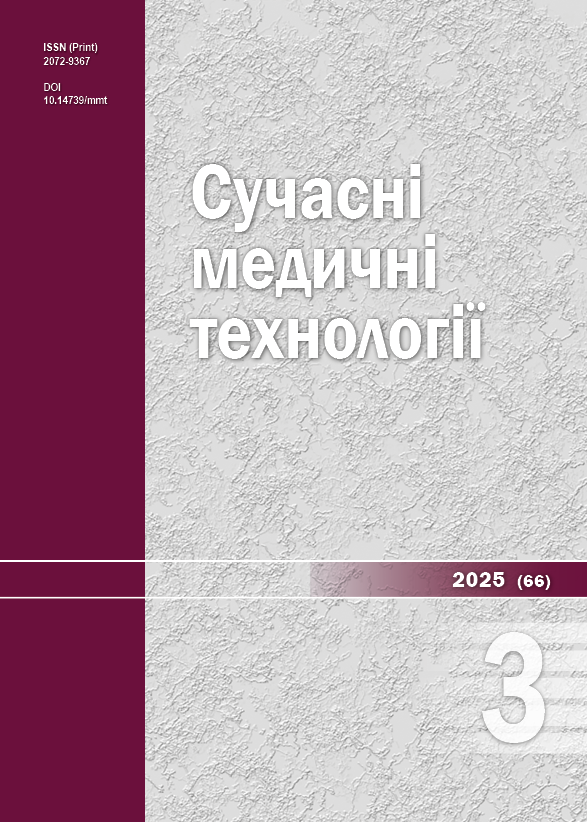Mechanical circulatory support in patients in cardiogenenic shock
DOI:
https://doi.org/10.14739/mmt.2025.3.337438Keywords:
extracorporeal membrane oxygenation, mechanical circulatory support, organization of extracorporeal life supportAbstract
Cardiogenic shock in acute myocardial infarction is a life-threatening syndrome characterized by systemic hypoperfusion that can rapidly progress to multiple organ failure and death. There are various mechanical circulatory support devices and configurations available to support patients, each with unique pathophysiological characteristics.
The aim. To investigate the effectiveness and causes of adverse outcomes of extracorporeal membrane oxygenation in the treatment of patients with cardiogenic shock.
Materials and methods. Between January 2024 and December 2024, 11 patients underwent venous-arterial extracorporeal membrane oxygenation in the state of cardiogenic shock at the Kovel-ECMO hospital district.
Results The survival rate was 72.0 % (8 patients). The successful cannulation rate was 100 %. The median cannulation time was 15 minutes. The median time before extracorporeal membrane oxygenation was 54 minutes. The median age was 50 years, and 100 % were male.
Conclusions. When using temporary mechanical circulatory support in patients with cardiogenic shock, a positive result was obtained in 72.0 % of patients.
References
Thiele H, Zeymer U, Akin I, Behnes M, Rassaf T, Mahabadi AA, et al. ECLS-SHOCK Investigators. Extracorporeal Life Support in Infarct-Related Cardiogenic Shock. N Engl J Med. 2023;389(14):1286-97. doi: https://doi.org/10.1056/NEJMoa2307227
Ostadal P, Rokyta R, Karasek J, Kruger A, Vondrakova D, Janotka M, et al. ECMO-CS Investigators. Extracorporeal Membrane Oxygenation in the Therapy of Cardiogenic Shock: Results of the ECMO-CS Randomized Clinical Trial. Circulation. 2023;147(6):454-64. doi: https://doi.org/10.1161/CIRCULATIONAHA.122.062949
Martin SS, Aday AW, Almarzooq ZI, Anderson CA, Arora P, Avery CL, et al. 2024 heart disease and stroke statistics: a report of US and global data from the American Heart Association. Circulation. 2024;149:e347-e913. 10.1161/CIR.0000000000001209. Erratum in: Circulation. 2024;149(19):e1164. doi: https://doi.org/10.1161/CIR.0000000000001247. Erratum in: Circulation. 2025;151(25):e1095. doi: https://doi.org/10.1161/CIR.0000000000001344
Tsao CW, Aday AW, Almarzooq ZI, Alonso A, Beaton AZ, Bittencourt MS, et al. Heart Disease and Stroke Statistics-2022 Update: A Report From the American Heart Association. Circulation. 2022;145(8):e153-e639. 10.1161/CIR.0000000000001052. Erratum in: Circulation. 2022;146(10):e141. doi: https://doi.org/10.1161/CIR.0000000000001074
Suverein MM, Delnoij TS, Lorusso R, Brandon Bravo Bruinsma GJ, Otterspoor L, Elzo Kraemer CV, et al. Early Extracorporeal CPR for Refractory Out-of-Hospital Cardiac Arrest. N Engl J Med. 2023;388(4):299-309. doi: https://doi.org/10.1056/NEJMoa2204511
Belohlavek J, Smalcova J, Rob D, Franek O, Smid O, Pokorna M, et al. Effect of Intra-arrest Transport, Extracorporeal Cardiopulmonary Resuscitation, and Immediate Invasive Assessment and Treatment on Functional Neurologic Outcome in Refractory Out-of-Hospital Cardiac Arrest: A Randomized Clinical Trial. JAMA. 2022;327(8):737-47. doi: https://doi.org/10.1001/jama.2022.1025
Gräsner JT, Herlitz J, Tjelmeland IB, Wnent J, Masterson S, Lilja G, et al. European Resuscitation Council Guidelines 2021: Epidemiology of cardiac arrest in Europe. Resuscitation. 2021;161:61-79. doi: https://doi.org/10.1016/j.resuscitation.2021.02.007
Greif R, Bray JE, Djärv T, Drennan IR, Liley HG, Ng KC, et al. 2024 International Consensus on Cardiopulmonary Resuscitation and Emergency Cardiovascular Care Science With Treatment Recommendations: Summary From the Basic Life Support; Advanced Life Support; Pediatric Life Support; Neonatal Life Support; Education, Implementation, and Teams; and First Aid Task Forces. Circulation. 2024;150(24):e580-e687. doi: https://doi.org/10.1161/CIR.0000000000001288
Yannopoulos D, Bartos J, Raveendran G, Walser E, Connett J, Murray TA, et al. Advanced reperfusion strategies for patients with out-of-hospital cardiac arrest and refractory ventricular fibrillation (ARREST): a phase 2, single centre, open-label, randomised controlled trial. Lancet. 2020;396(10265):1807-16. doi: https://doi.org/10.1016/S0140-6736(20)32338-2
Møller JE, Thiele H, Morrow D, Kjærgaard J, Hassager C. Mechanical circulatory support: when, how, and for whom. Eur Heart J. 2025;46(16):1480-92. doi: https://doi.org/10.1093/eurheartj/ehae925
Hála P, Mlček M, Ošťádal P, Popková M, Janák D, Bouček T, et al. Increasing venoarterial extracorporeal membrane oxygenation flow puts higher demands on left ventricular work in a porcine model of chronic heart failure. J Transl Med. 2020;18(1):75. doi: https://doi.org/10.1186/s12967-020-02250-x
Richardson AS, Tonna JE, Nanjayya V, Nixon P, Abrams DC, Raman L, et al. Extracorporeal Cardiopulmonary Resuscitation in Adults. Interim Guideline Consensus Statement From the Extracorporeal Life Support Organization. ASAIO J. 2021;67(3):221-8. doi: https://doi.org/10.1097/MAT.0000000000001344
Belohlavek J, Rob D, Smalcova J. Effect of intra-arrest transport and extracorporeal cardiopulmonary resuscitation on functional neurologic outcome in refractory out-of-hospital cardiac arrest-reply. JAMA. 2022;327(23):2357. doi: https://doi.org/10.1001/jama.2022.6548
Downloads
Additional Files
Published
How to Cite
Issue
Section
License
Copyright (c) 2025 V. H. Tanskyi

This work is licensed under a Creative Commons Attribution-NonCommercial 4.0 International License.
The work is provided under the terms of the Public Offer and of Creative Commons Attribution-NonCommercial 4.0 International (CC BY-NC 4.0). This license allows an unlimited number of persons to reproduce and share the Licensed Material in all media and formats. Any use of the Licensed Material shall contain an identification of its Creator(s) and must be for non-commercial purposes only.














